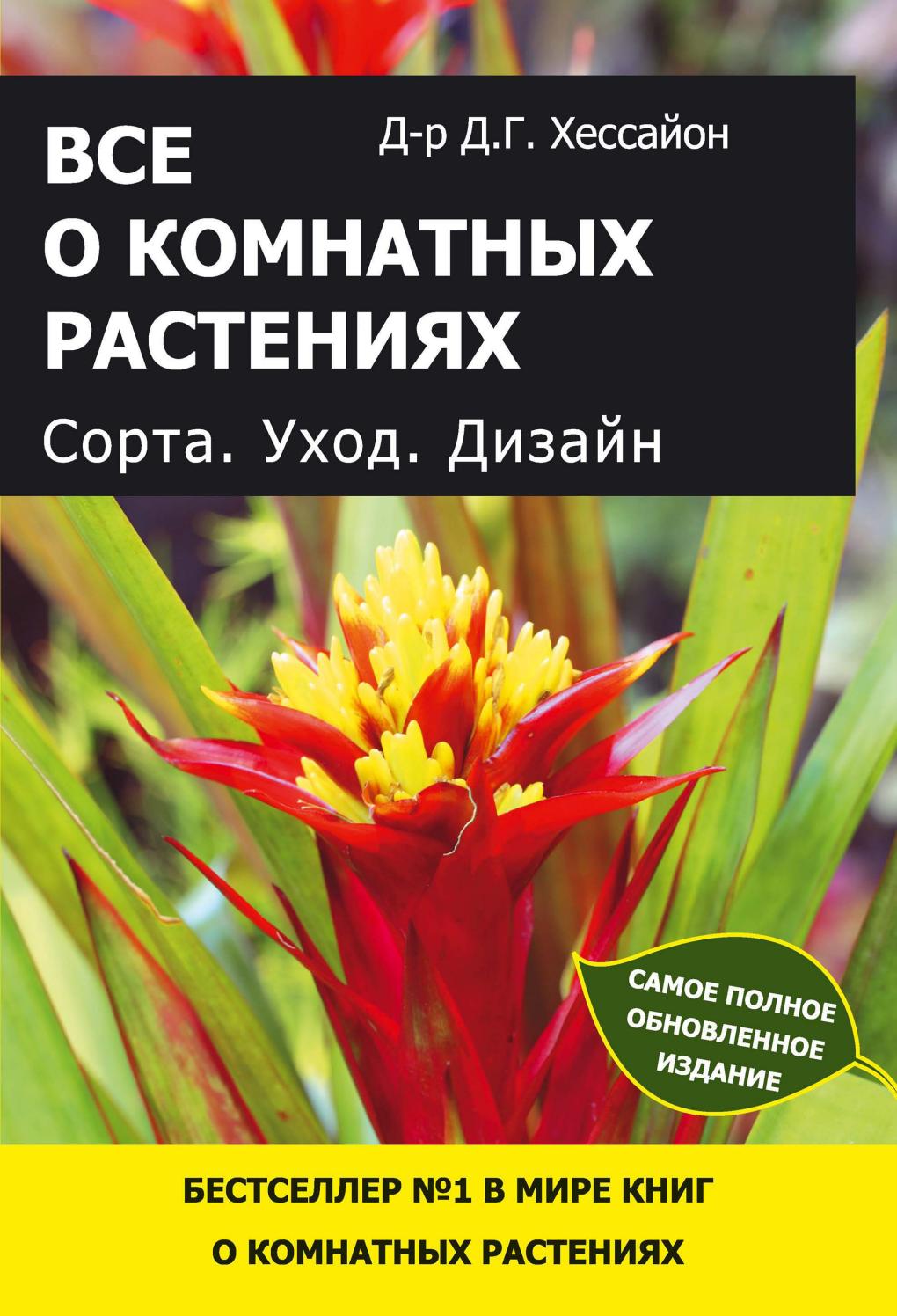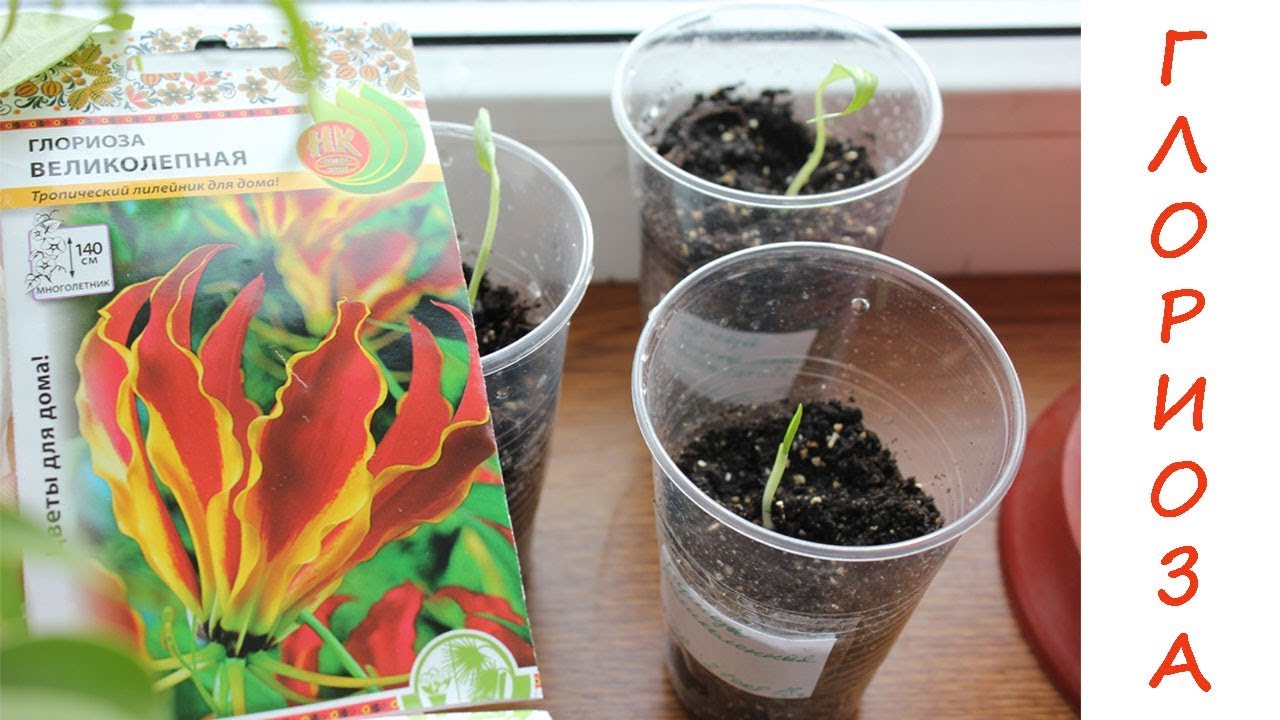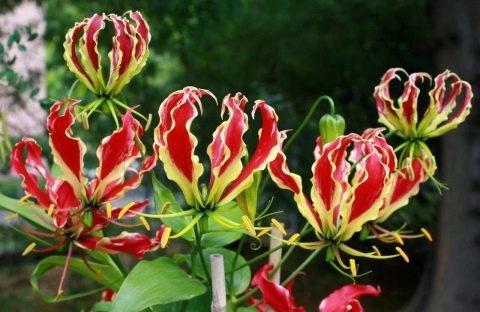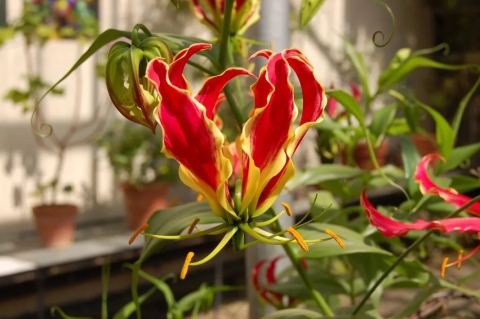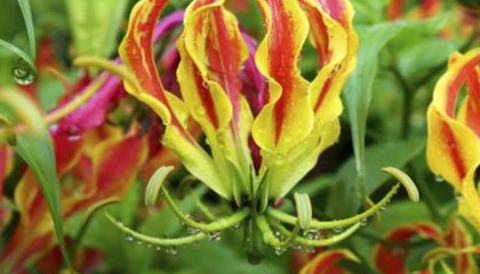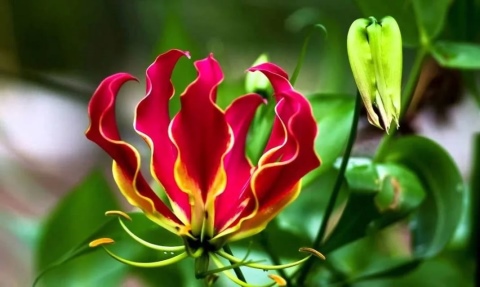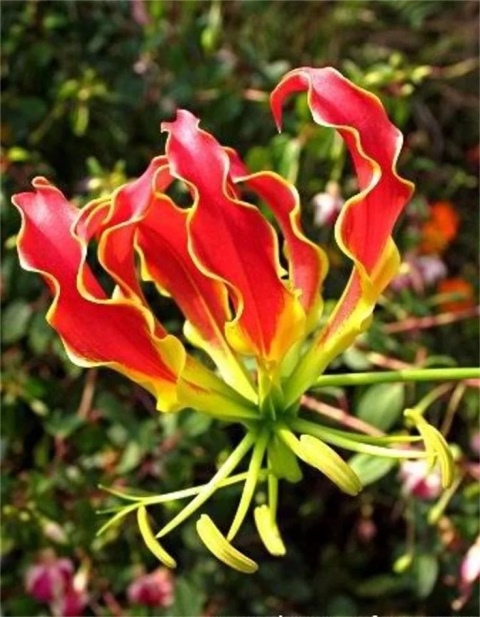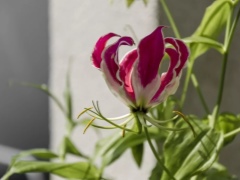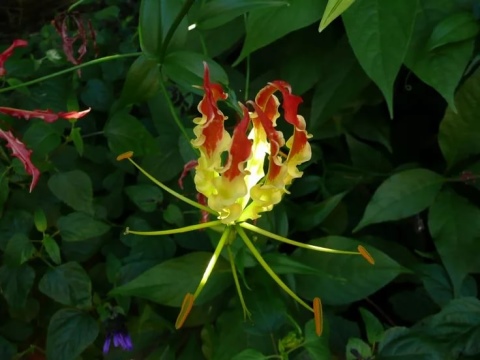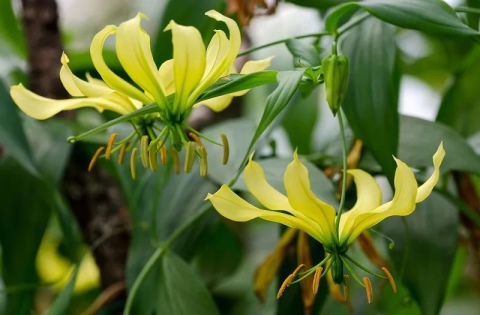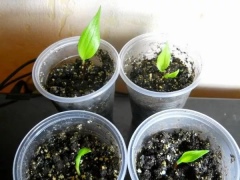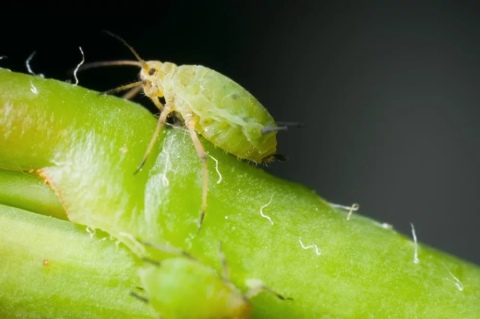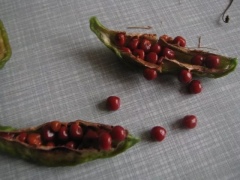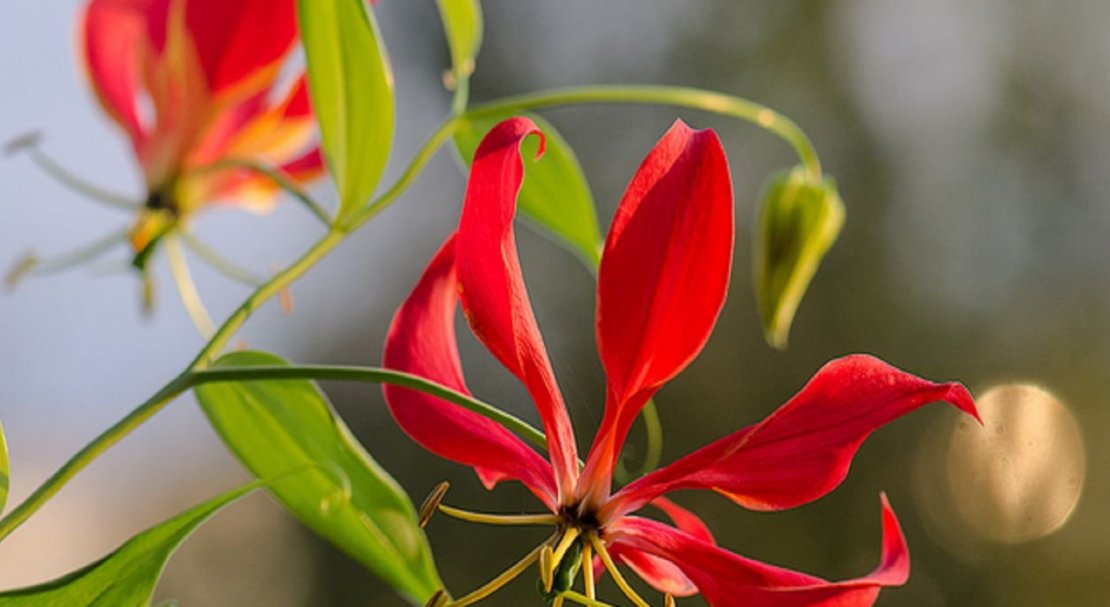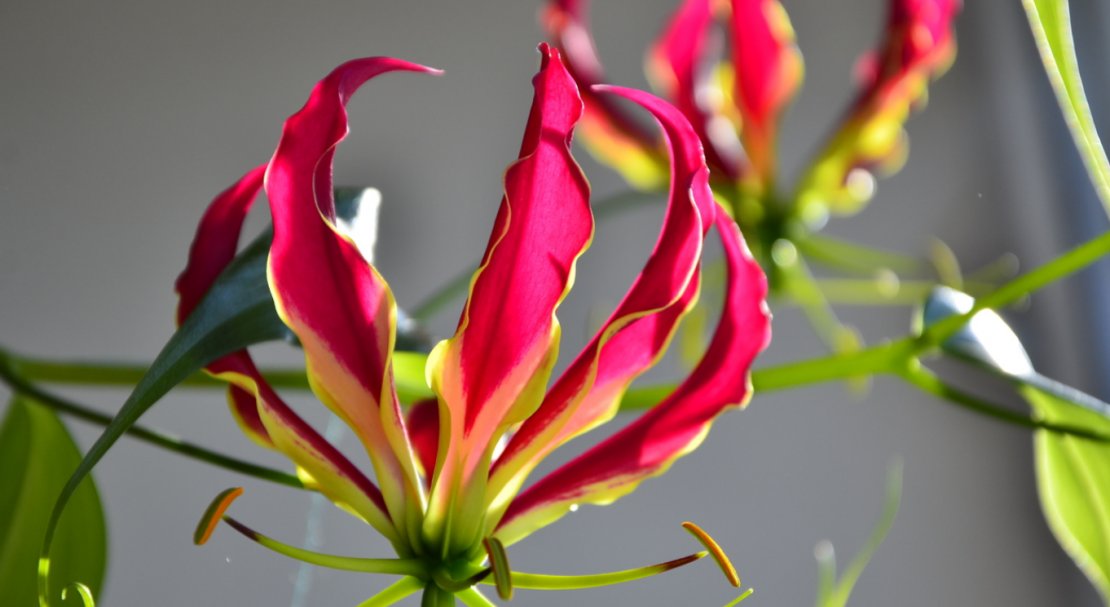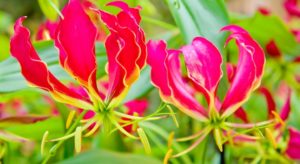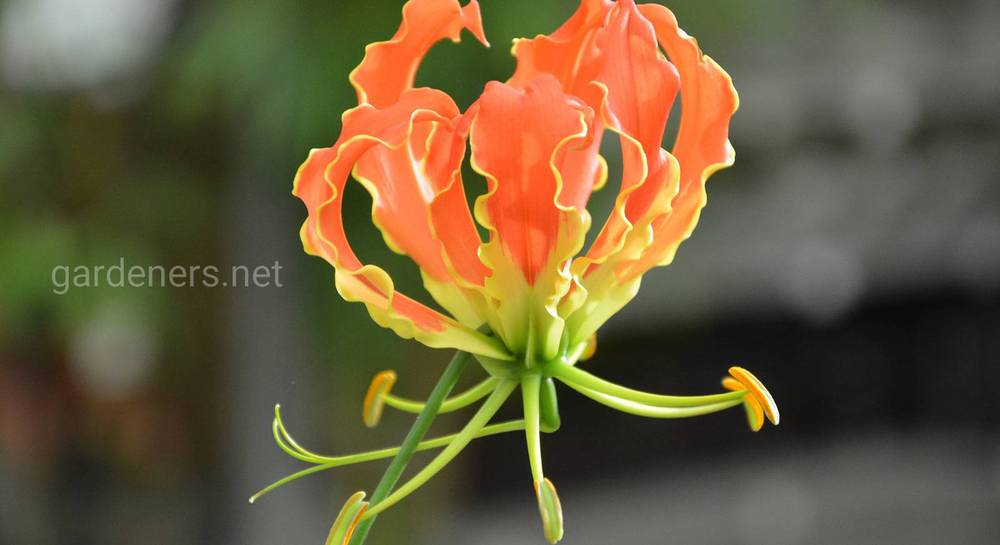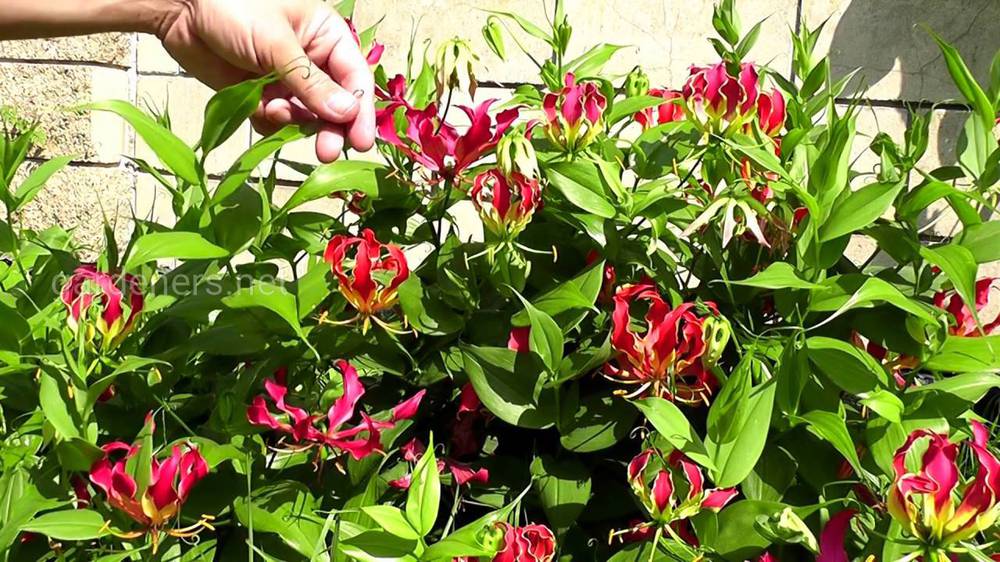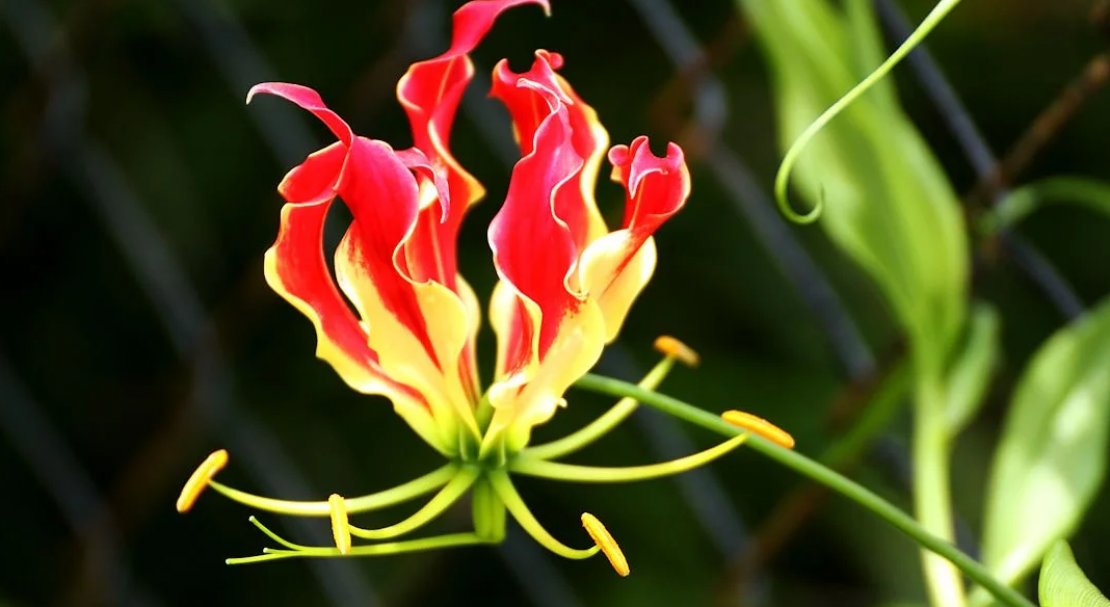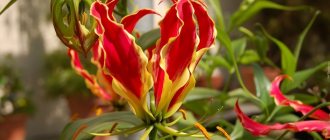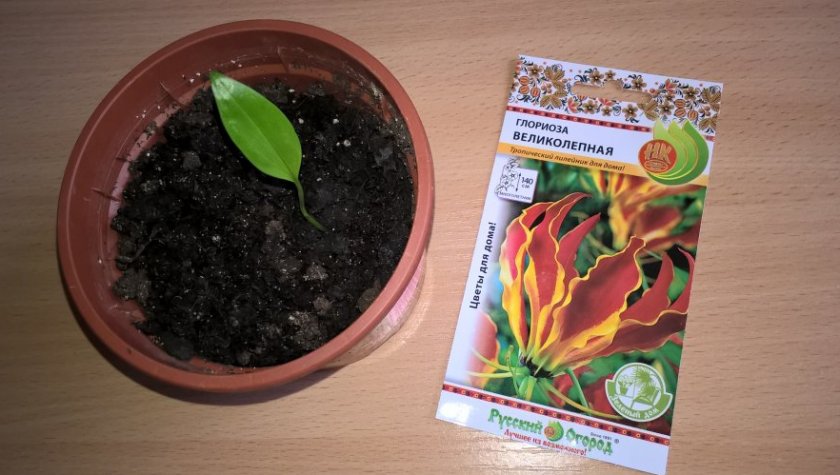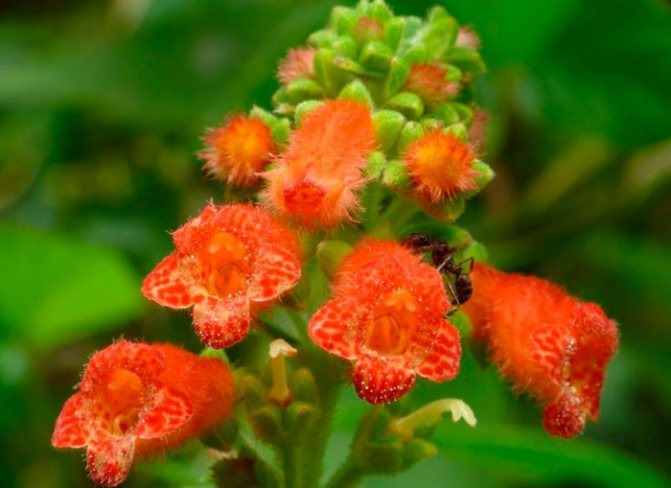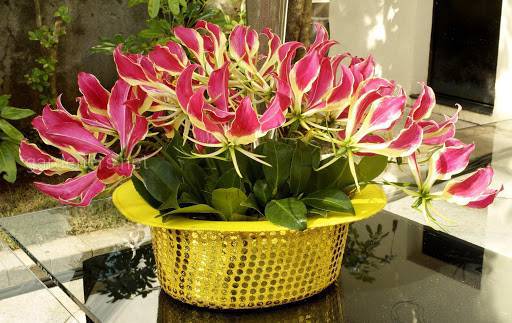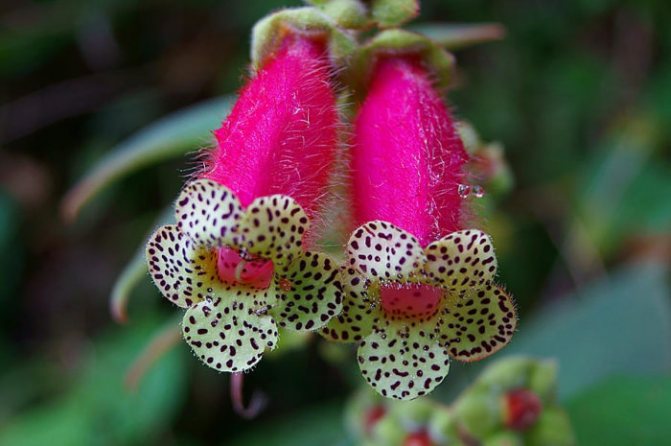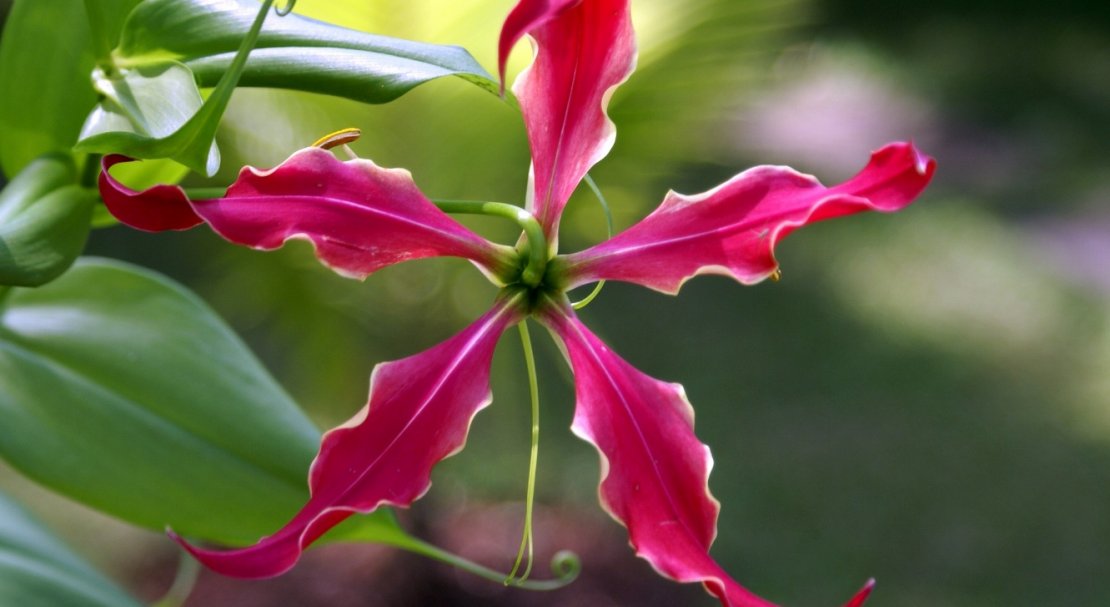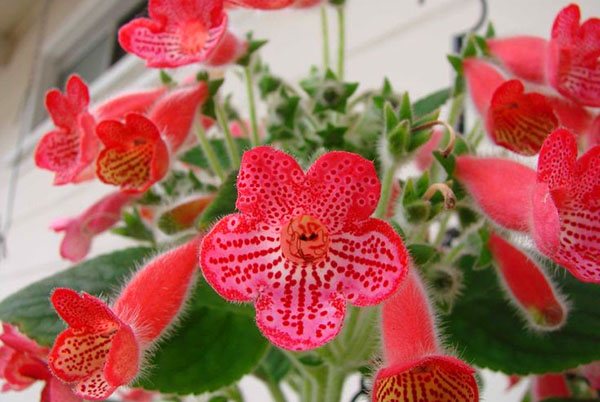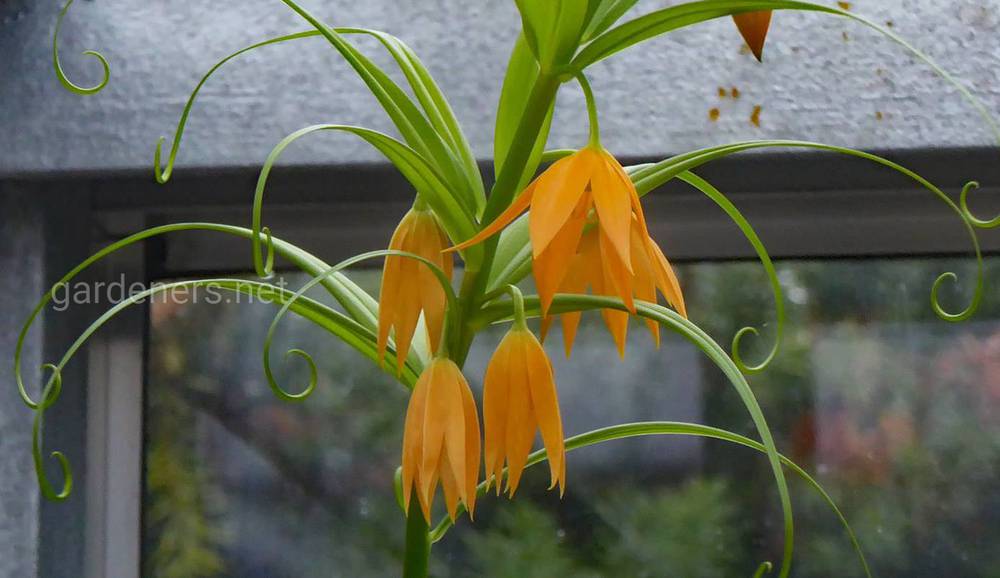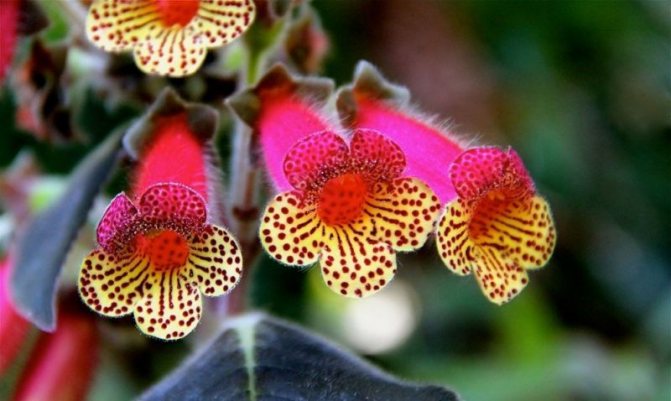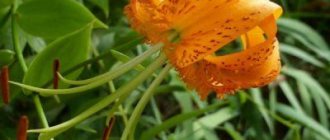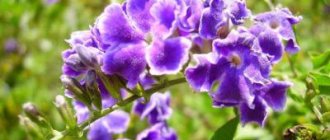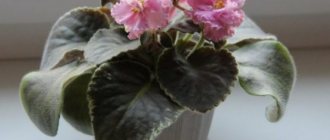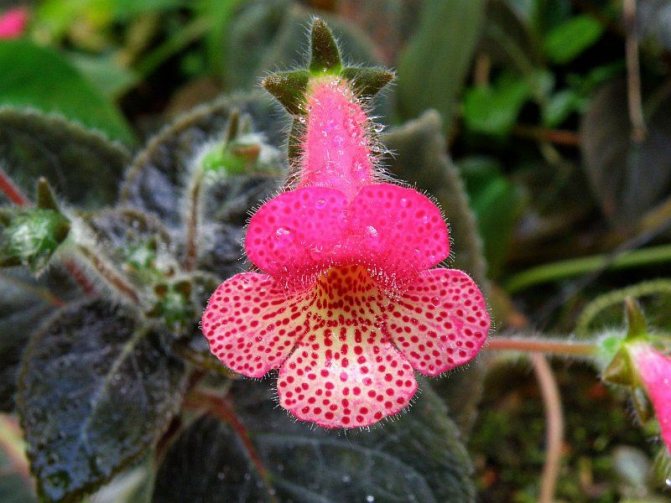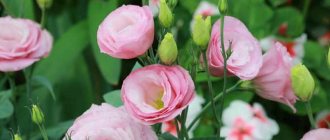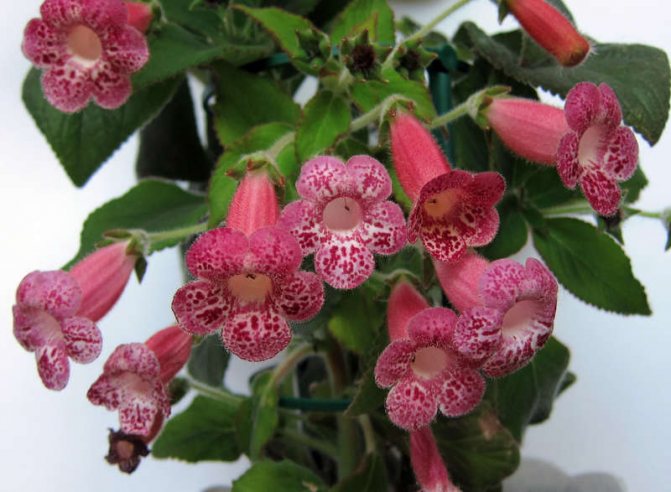Gloriosa care at home
Lighting
Bright, diffused light is just what you need to grow gloriosa at home. The best option is windows on the west and east sides, on the south windows you need to hide from direct sunlight. After purchase or prolonged cloudy weather, gloriasis is gradually accustomed to bright light.
Temperature
In spring and summer, gloriasis should be kept at temperatures between 20 and 25 ° C. Drafts and cold air can be very damaging to the plant. Winter is a dormant period for gloriosa. When the flowering of the plant ends in the fall, watering is gradually reduced, and then completely stopped. In early to mid-autumn, the aboveground part of the gloriosa dies off. Dig up the tubers, lightly sprinkle with sand and store in a moderately warm place at a temperature of 8 to 10 ° C until planting.
Watering gloriosa
Indoor gloriasis is watered with settled soft water. In summer and spring, it is abundant, after the topsoil has dried out. The earthen ball should be slightly damp all the time. In winter, the plant is not watered.
Spraying gloriosa
Gloriosa in indoor conditions requires high air humidity. The plant can be placed on a pallet with moistened pebbles or expanded clay, but care must be taken that the water does not touch the pot. It will not be superfluous to spray the plant every day, but only so that water does not get on the flowers - spots may appear and the plant will lose its decorative properties.
Gloriosa bloom
In summer, domestic gloriosa blooms very beautifully. The flower tilts and the perianth rises, which looks beautiful and attracts insects. They say that butterflies cannot sit on a flower and drink nectar on the fly, and the flapping of their wings swing their anthers and pollen flies over the stigma. With age, the yellow color changes to red, and the flowers themselves do not bloom all at the same time, but open in turn - up to 7 inflorescences in 1 season.
Fertilizing gloriosa
When the shoots get stronger in spring, they are fed with a special liquid fertilizer for indoor plants. Throughout the flowering period, instructions are fed accordingly.
Gloriosa support
The gloriosa flower is a vine that holds onto a support with tendrils at the ends of the leaves. The stem is fragile, and since antennae may be missing at the bottom of the stem, so that the latter does not break, it must be tied up. The stem will not grow around the support, because The antennae cover only a thin wire, so you need to tie up the stem if you can't place a thin support. In May-June, indoor gloriosa is actively growing and can grow up to 2 m, which is not desirable
To reduce the length of the plant, it is necessary to direct the stem downward, carefully bending it
Gloriosa transplant
Plants should be replanted every spring. It is advisable to take a ceramic pot, low and wide. The best substrate is leafy and humus soil, peat and sand (2: 4: 0.5: 0.5). It is necessary to make high-quality drainage. They plant the tuber of the plant horizontally, sprinkling it with soil just a couple of centimeters. The gloriosa tuber has only one bud, the loss of which will lead to the infertility of the tuber, because the gloriosa flower will not germinate from part of the tuber. The plant is planted in late winter - early March, the substrate should be slightly damp all the time, and the temperature should be from 15 to 20 ° C. After the shoots appear, you need to rearrange the pot on a light windowsill.
Reproduction of gloriosa tubers
Basically, the gloriosa plant is propagated by tubers, which are planted in 13-centimeter pots in mid-spring in a soil mixture of humus, leafy, turfy land and sand (2: 2: 1: 0.5).The tuber is planted with a sprout up (with an angular fold at the top) and sprinkled with a 3 cm layer of soil. Better to use a bottom heater and keep the temperature at 20-24 ° C. Watering begins only after the sprout appears. The shoot is tied to a peg. When the roots completely encircle the pot from the inside, the gloriosa is transplanted into a larger pot or into open ground.
Gloriosa from seeds
When glorious seeds multiply, the plant develops slowly. To obtain seeds, the plant is pollinated by transferring the pollen with a brush on the stigma of the same specimen. The seeds are collected and immediately planted in a substrate of equal parts of turf, peat and sand. You need to sow seeds at a temperature of 20 to 24 ° C, and these plants will bloom only in the 3rd year.
Gloriosa toxicity
Gloriosa tubers cannot be eaten - they are poisonous. It is necessary to ensure that animals and children do not have access to the plant.
6 Growing problems
When growing this vine, certain problems can arise. The most common are presented in the table:
| Problems | Possible reasons |
| Drops of liquid on the leaves | Abundant watering when kept in a room that is too warm |
| Formation of white plaque on the surface of leaves and petals | Watering with hard and / or cold water |
| Slow shoot growth, drooping and darkened leaves | Sudden temperature changes, drafts |
| Yellowing of the leaves combined with drying out of their tips | Rare and (or) insufficient watering, too dry air |
| Lack of flowering | Incorrect selection of the pot - too spacious; incorrect organization of wintering; damage to the tuber during transplantation; lack of light |
Gloriosa is an unusual and beautiful plant
She needs special seasonal care and careful handling
For the care and attention, the liana will thank its owner with an unforgettable long and spectacular flowering.
Gloriosa Rothschild: planting and care
Gloriosa Rothschild is part of the Lily family and comes from the territory of South Africa. These delicate flowers rise upward with tendrils at the tips of the leaves. All parts of the plant, including the root stock, are dangerous with any touch, and especially when ingested.
The plant in indoor conditions is recommended to be planted in a shallow pot of two parts of the soil - peat and sand. After soil preparation, planting is carried out. It is also a good idea to keep it in place with indirect light and be careful to keep the soil evenly moist.
As soon as the Rothschild gloriosa begins to grow, it must be transferred to a place with a lot of sun and the amount of watering will increase. The temperature should not drop below 19 degrees.
After the end of the flowering period, stop watering and fertilizing so that the plant can calmly rest during the winter.
After wintering has passed and the danger of frost is over, choose a suitable spot in your garden - with trellises or near the plant - so that they can support gloriosa during growth and development.
When planting gloriosa, the tubers are planted at a distance of 12 centimeters from each other in an L or V-shape. Before the first shoots appear, the sprouts should be actively watered, and after that, the soil should be kept moist, but in no case damp.
You can grow from one to three flowers in one container during the winter.
Caring for the Rothschild gloriosa, it is necessary to water and feed the flower with fertilizers throughout the entire time of growth and development. The preferred temperature range is from 17 to 25 degrees Celsius (with high humidity levels, the temperature can be higher).
After flowering, watering should be stopped gradually, waiting for the foliage to sag at all. After that, dig out the tubers, which by the way may be much deeper than they were when planting - so be very careful.
To prevent fungal and other plant diseases, we advise you to treat the root with sulfur and clean it.The tubers themselves can be divided into several parts and used for further transplantation, just make sure that each of them has a bud - the so-called growing point.
Experienced gardeners advise storing Rothschild gloriosa tubers in dry peat or vermiculite in winter (three to six months). You can also leave them in a dry potted soil until spring begins when they need to be transplanted into new soil.
Possible problems
Gloriosa is not the easiest vine to grow. Failure to comply with the care regimen, storage of tubers is harmful to the plant.
| Problem | Causes |
|---|---|
| Slow growth and lack of flowering | Storage of tubers in the cold, damage, stem fracture. |
| Slower growth of shoots, darkening, drooping of leaves | Temperature jumps, excessive watering, stagnant water in the pot. |
| Browning or yellowing of leaves at the tips | Dry air and poor watering. |
| Sluggish, soft stems, yellowing of leaves at the base | Possibly root rot as a result of poor drainage, excessive watering, low temperatures, and a large volume of soil. |
It is infrequently affected by pests. Sometimes a scale insect or aphid can "migrate" from neighboring plants. It is recommended to deal with them with solutions of drugs "Aktara" and "Confidor". In fact, growing gloriosa is tricky, but not as difficult as it might seem at first glance. All the subtleties of care can be mastered in one season.
{SOURCE}
Growing at home
With proper home care, gloriasis will look spectacular. The main thing to consider is that the plant is accustomed to the hot tropical climate and abundant watering during the rainy season, so it cannot tolerate frost. There are several ways to propagate a flower, but the easiest way is to buy a young plant from a store.
When growing gloriosa at home, there is a way to plant it outdoors. In summer, when the air temperature is stable at 25-27 degrees, it can be placed outside, and with the first cold snaps, it can be taken into the house or greenhouse along with the rhizome and earthen lump.
Gloriosa breeding methods
In the photo, gloriasis when caring at home may differ. This plant can grow large or give small, straight shoots. If there is already one such flower on the windowsill, it can be propagated in two ways. In nature, after a period of flowering, seeds are formed at the tops of the shoots. They crumble into the ground, take root, and the next year small shoots are obtained from them.
Tuber propagation
The easiest way to propagate gloriosa is with rhizomes. It belongs to tuberous plants, and when dividing the tuber, each of the parts forms full-fledged long shoots. Reproduction is carried out in the spring, when the flower is transplanted into a new container. The procedure is simple:
- the rhizome is removed from the ground and carefully cut with a knife into several equal parts;
- the place of the cut should be processed with crushed charcoal;
- each tuber is planted in a separate pot and sprinkled with earth a few centimeters;
- watering can be started only when the first sprout appears, and before that, you can warm up the plant by placing it on a warm surface.
Seed propagation
The method of growing gloriosa from seeds is longer. It grows for a long time, and although the shoots appear quickly, the first flowering period will not come earlier than 3-4 years after planting. However, if it is not possible to get tubers from an adult healthy plant, you can also grow a full-fledged liana from the seeds.
For propagation by seeds, it is necessary to pollinate the plant. Gloriosa refers to self-pollinating flowers, and the procedure can be carried out at home:
- pollen with a brush is transferred to the flowers of the same plant;
- after flowering, seeds will be tied;
- they must be collected and planted in fertile soil;
- before the sprouts take root, cover them with glass and ventilate them periodically.maintaining a temperature of at least 20 degrees.
When small leaves appear on the seedlings, the plants can be transplanted into separate pots and an irrigation system can be established. Under conditions of proper care, gloriosa grows rapidly, but at home its height rarely exceeds 50-60 cm. Large plants can be grown if they are taken outside in the summer. In the third year, it will be possible to observe how the first bright flowers appear.
Care advice
Indoor gloriosa is a plant that requires special care. It is adapted to hot tropical climates with irregular but abundant watering. The flower grows well in fertile soil. It is worth adding humus, compost, peat and sand to the purchased mixture. Fertilizers are periodically reintroduced - the procedure is convenient to carry out in the spring, when the plant is transplanted into a larger pot.
There are several recommendations on how to grow large and healthy gloriosa, as well as wait for flowering faster:
- place the flower pot on the well-lit side, and gradually adapt it to the sun before taking it outside in the summer;
- the period of active growth occurs in late spring and early summer - at this time the flower needs abundant watering with water at room temperature;
- in the fall, vital processes slow down, it is worth reducing watering and moving the pot to a less illuminated place;
- gloriosa prefers to grow in conditions of high air humidity, so you can additionally spray the leaves from a spray gun.
The flower's rhizome is not too large, so a small but deep pot will do. At its bottom, there must be holes for the outflow of excess moisture and for ventilation of the roots. In addition, it is imperative to place a drainage layer before adding soil. For these purposes, purchased expanded clay drainage or small pebbles are suitable. A high support is placed in the center of the pot - the plant will adhere to it with special antennae, since its shoots are long and not strong enough.
Growing problems, diseases, pests
Gloriosa is rarely attacked by insects. But, nevertheless, it can be harmed by aphids, scale insects and spider mites. Also, improper growing care can lead to the fact that the plant loses its attractiveness.
Ways to fight
Parasites, namely aphids and mites, do not like high humidity. Frequent spraying and insecticide treatments will help get rid of them. The shield will have to be removed manually before the procedure.
If the leaves of the gloriosa turn pale, it does not have enough light, you need to change the position of the flower. When a white coating appears on them, it is necessary to better defend the water. Yellow leaves appear with insufficient or excessive moisture, it is worth revising the conditions for keeping the plant. If the plant looks drooping, it starts to rot, this happens with over-watering.
Gloriosa is a tropical vine that can decorate any apartment. The colorful bloom will not leave anyone indifferent. To keep the bright, chic gloriosa, planting and caring at home is not difficult, with the exception of one nuance. The difficulty in the need to send the plant for the winter, observing the temperature regime. But even this is easy to deal with if you re-read the article again.
vote
Article Rating
Home care
Accommodation
Gloriosa requires a lot of bright, diffused light and fresh air.
An excellent location will serve as southern windows (with shade in the summer afternoon), it also grows well on the east or west side.
Temperature
Gloriosa is very thermophilic. The optimum temperature is + 20 ° - + 25 °.
In summer, in warm weather, it is recommended to put gloriosa on the balcony, but to protect it from the coolness of the night - to bring it indoors at night.
After the dying off of the aboveground part of the plant in autumn and the transition to a dormant period, the plant is placed in a dark place with a temperature of + 10o - + 12o.
The transition from "summer" temperature to "winter" should be smooth without sudden jumps and fluctuations.
Humidity
For the healthy development of gloriasis, high humidity is required - 70-80%.
The easiest way is to spray it frequently. But, for reliability, you can put a container with water or a humidifier next to the plant.
During the flowering period, you need to ensure that drops of water do not fall on the flowers.
Gloriosa flower
Watering
Gloriosa requires a lot of moisture. Water the plant regularly, as the topsoil dries out and prevent it from drying out
This is especially important during the period of active growth and flowering.
In autumn, watering is reduced, and by winter, the dormant period, they stop altogether.
For irrigation, use only soft, settled water with a temperature slightly above room temperature (+ 26o - + 28o).
Top dressing
During the period of active growth, regularly feed the plant with complex fertilizers for deciduous plants, closer to summer - the flowering period - switch to fertilizers for flowering plants.
The regularity of feeding is 1 time in 7-10 days.
By winter, feeding is reduced, and during the rest period they are completely abandoned.
Dormant period
At the end of flowering, the plant prepares for a dormant period. The leaves and the entire aerial part gradually die off.
The gloriosa tuber is removed from the pot and completely placed in sawdust or peat and placed for the winter in a dry, ventilated place with a temperature of about + 10o - + 12o.
It is not recommended to store wintering tubers in the refrigerator due to the risk of rotting from high humidity.
! You can leave the tuber in the pot, but in the spring the plant will still have to be removed from the pot and transplanted, but in this case there will be a risk of damaging the awakening buds.
A properly organized dormant period guarantees the emergence of healthy flower buds and abundant flowering.
Gloriosa in the garden
Transfer
The transplant is carried out in the spring from mid-February to early March. During this period, you should carefully monitor the tubers, and, at the first signs of awakening, start planting.
Tubers are very carefully removed from the "winter" substrate. The pot is chosen wide and shallow, small - no more than 18 cm in diameter, size
The pot is chosen wide and shallow, small - no more than 18 cm in diameter, size.
A drainage layer and moistened soil are poured into the pot.
The soil is composed of sod and leafy soil, peat and coarse sand or perlite in a ratio of 2: 2: 1: 1.
The tuber is planted, deepening approximately 1/3, and no more than half, buds up.
Install a suitable support immediately.
The planted roots are placed in bright light. The temperature is raised gradually up to + 20 °.
The first time the planted plant is watered by spraying, preventing possible root decay.
With the appearance of greenery, you can gradually switch to regular watering.
Gloriosa tubers
Pruning gloriosa
Despite the fact that gloriosa is considered a climbing vine, capable of clinging to almost any support with the help of tendrils at the ends of the leaves, in fact, everything is not so simple and gloriosa will need help to form its formation. The thing is that the antennae are most often absent on the lowest leaves, therefore, at the initial stage of shoot development, it is necessary to tie them to a support so that the vine itself can then climb over it.
At the same time, it is worth clarifying that the shoots of gloriosa do not twine around the support, the vine only clings to it and its shoots are quite fragile. And the antennae do not differ in their large size and great tenacity, because of which the gloriosa on its own can only cling to relatively thin beams or wire. If the support is massive, then the vine must be tied up constantly, directing and thus evenly distributing it over the support. But the ladders with thin twigs will help her form a dense crown on her own.
Take your time to prune gloriosa, even if the shoots appear to be overly long.It is best to contain the gloriosa by periodically directing the shoots downward, as if twisting it around the support. Pruning does not have a very good effect on flowering, since gloriosa produces their luxurious fiery inflorescences mainly on the upper leaves. Therefore, it is best not to cut the tops of the shoots, but to direct the plant so that it maintains a compact growth form.
Be very careful when tying, especially if the shoots need to be bent: they break too easily. Extreme care should be taken when transplanting a plant.
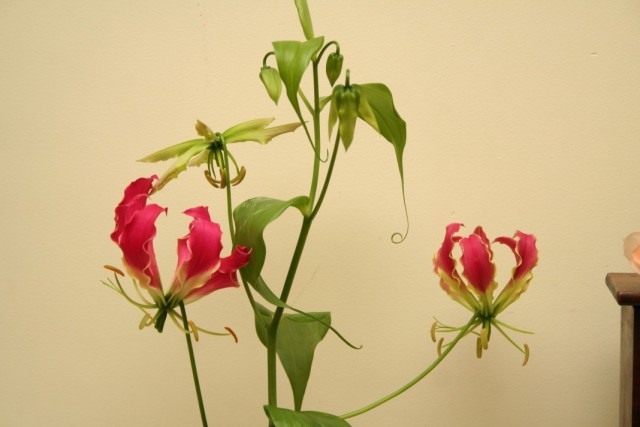 Gloriosa (Gloriosa). baronvonthierry
Gloriosa (Gloriosa). baronvonthierry
Popular species and varieties
Among the most popular varieties of gloriosa, the following specimens are grown at home.
"Luxurious" ("Magnificent"). The most popular flower that is in demand for home cultivation due to its beautiful flowering. The color of the perianths is varied - on the outside, the lobes will be painted pink, on the inside, the base will be yellow with red tips. The culture will bloom between June and September.
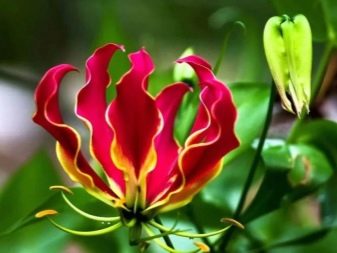
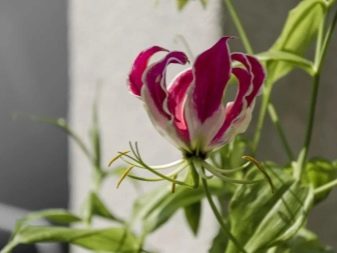
"Rothschild". The flower stands out with curly petals. They will be yellow and red. The plant is able to enter the flowering phase in the spring, capturing several autumn months.
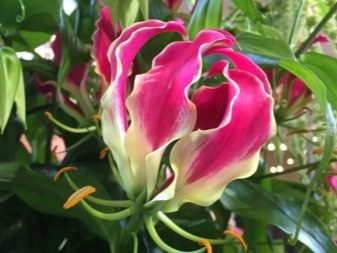
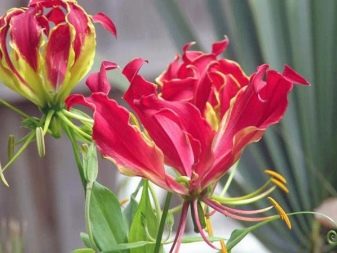
Daisy. This culture is artificially bred. The hybrid is an annual, herbaceous plant, therefore, is not able to form branchy vines. However, the color of the flower will be no less expressive than that of the above varieties. It is dominated by yellow, orange and red shades.
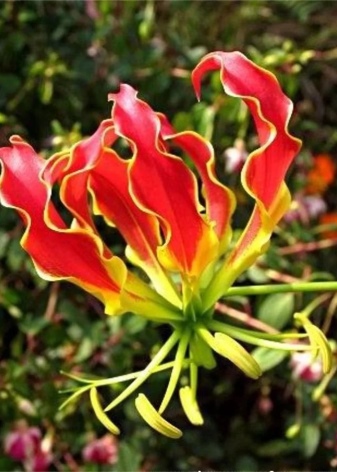
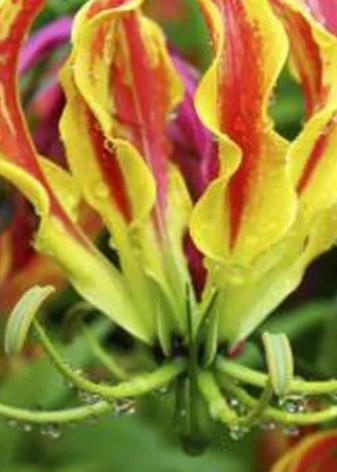
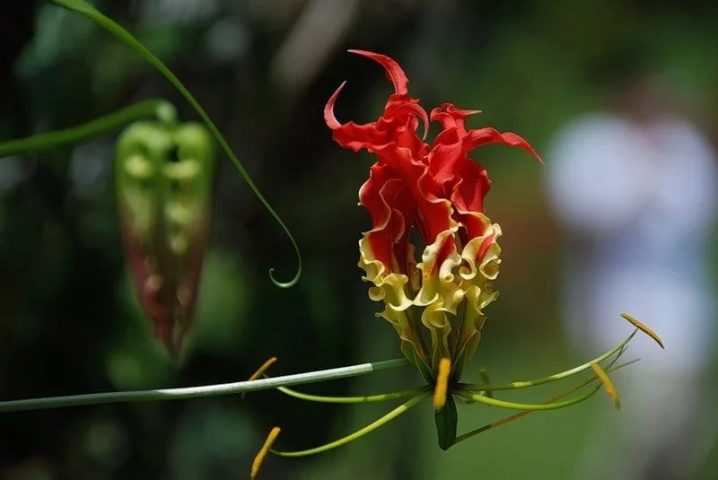
Carson. A small plant whose flowering is accompanied by the formation of deep red flowers, while the perianths will be yellow with curved tips.
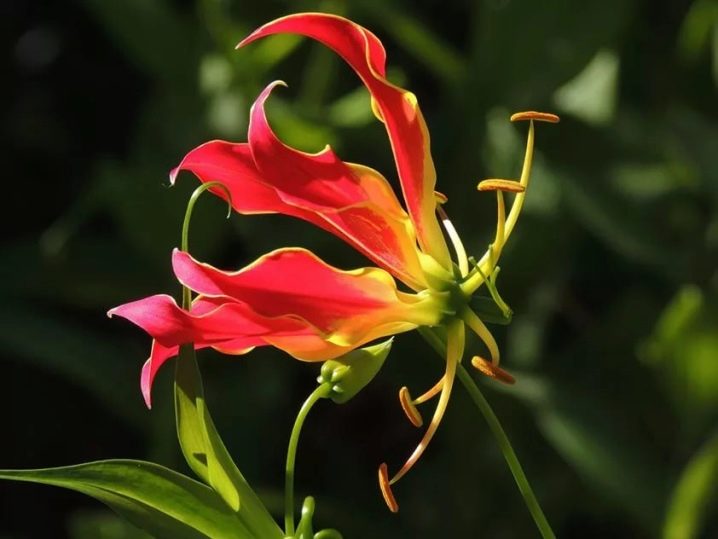
Varieties and varieties of gloriosa
In nature, there are no more than 10 varieties of gloriosa. For home cultivation, 3 main varieties are most often offered. They grow in different regions, but they do well at home in pots.
Gloriosa luxurious
Gloriosa luxurious is the variety that is most commonly found naturally. It grows in the tropics, preferring a humid climate, can rise 1.5 km above sea level. This is a large flower - its shoots reach 2 m in length, but they are not strong enough and must be attached to the support. The flowers are large. individual petals grow up to 8 cm. Outside they are pink, inside their color changes from yellow (closer to the core) to bright red at the ends. The second name of the variety is magnificent gloriosa.
Gloriosa simple
This variety is widespread in the tropics of Africa. Its shoots grow up to 1.5 m, the leaves are characteristic of the gloriosa species. The flowers are medium-sized, the petals reach 3-5 cm, at the base their width is about 3 cm. They have a yellow-green color with a transition to red, straight, practically not bent inward.
Gloriosa Rothschild
Gloriosa Rothschild is another variety of this plant that is suitable for growing at home. Unlike other varieties, it has branched shoots, each of which must be attached to a support. The petals are quite large, each can reach up to 10 cm in length. They are red, covered with purple spots, slightly curved outward at the ends.
Gloriosa is one of the few exotic plants that can be grown at home. It is not very whimsical in care and maintenance, it is enough to maintain an optimal temperature regime and regularly moisten the soil. Different varieties of gloriosa are perennial plants, and the first flowers appear only a few years after the seeds are planted in the ground. However, when performing all work and contact with a flower, it is worth observing safety rules and using protective gloves. It is also worth limiting the access of pets to it - there is a strong poison in the green mass and tubers.
Gloriosa care at home
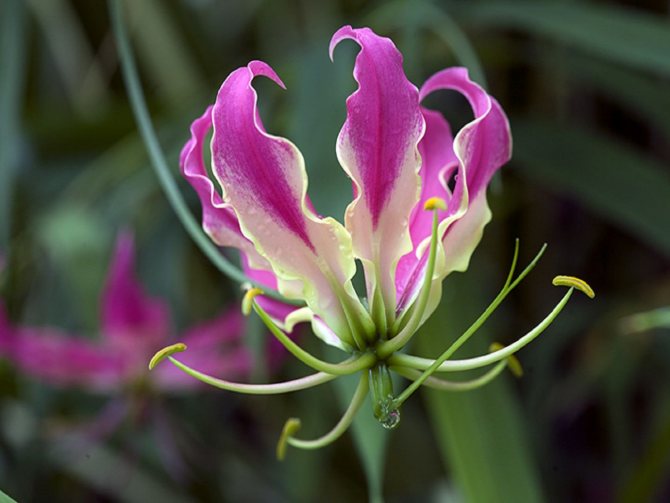
It is best to purchase a plant in specialized stores. For sale, indoor flowers are grown in special greenhouses in conditions of high humidity and air temperature. Without preliminary hardening, the plant most often dies or begins to hurt. In flower shops, cultures go through this procedure and therefore it is easier to tolerate moving and new conditions. The leaves of the selected plant should be healthy, free from pests and signs of disease. The stem is evenly leafy, succulent, with green leaves. Does gloriosa prefer careful or unpretentious care? This question is often asked by novice growers.
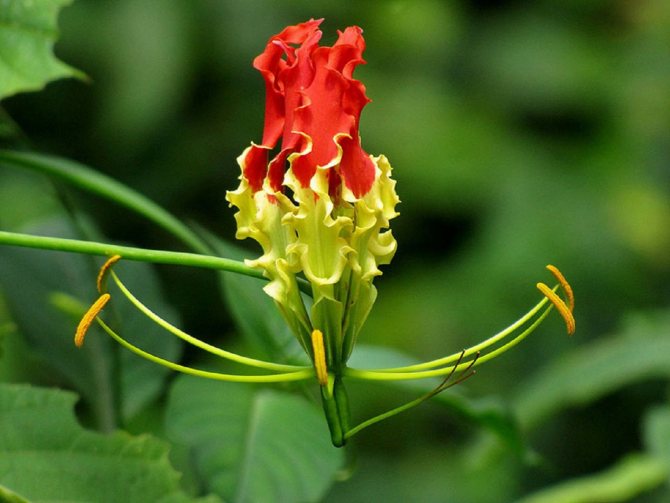
The plant is not capricious, the content of the flower consists in systematic moderate watering of the indoor plant, providing warm diffused light, maintaining a comfortable air temperature.
After the shoots die off, in the absence of watering, the roots can be stored at room temperature. In February, luxurious gloriosa tubers are ready for germination.
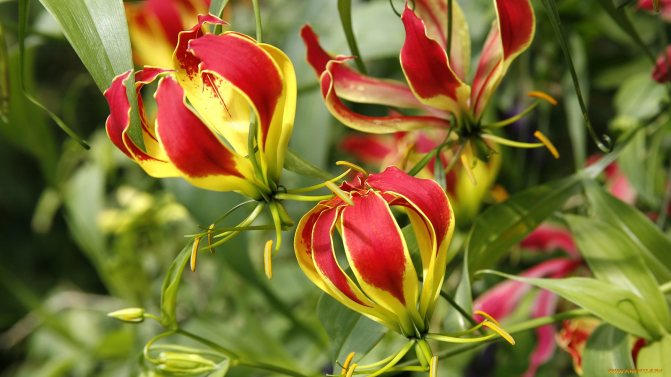
Location and lighting
Lighting is one of the most important factors in the development of indoor crops. Under the influence of sunlight, the process of photosynthesis takes place in the leaves, and when there is insufficient light, they become too pale and dull. However, too intense light can be harmful to the plant. Often it becomes the cause of the appearance of brown and gray spots on the leaves - sunburn.
Gloriosa needs a bright, sunny, warm place. In summer, you need to protect it from direct sunlight, you can take it out into the fresh air, onto a balcony or loggia and tie the shoots to a support.
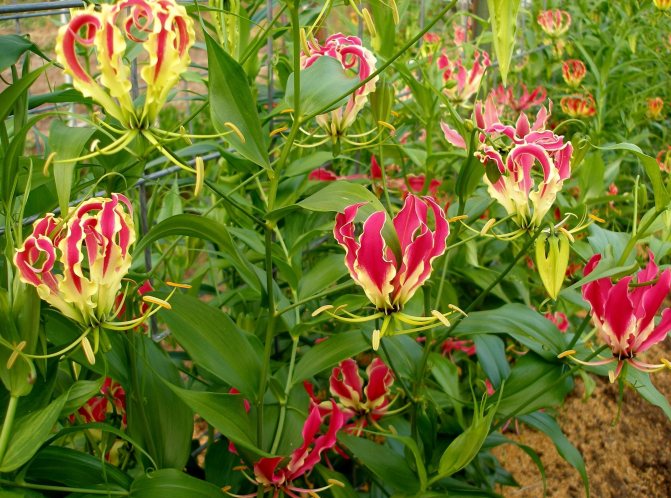
Air humidity
Gloriosa needs high air humidity. It is necessary to carefully spray the plant every day, but only so that the water does not come into contact with the flowers, since moisture can provoke the appearance of stains, which will spoil the decorative attractiveness of the culture.

Watering
Without exception, all indoor crops need watering, since without water they inevitably die. Water is of great importance for all vital processes of a plant: photosynthesis, assimilation and movement of mineral substances, temperature regulation. For plants, not only a lack, but also an excess of water is destructive.
In summer, watering should be normal, the soil should remain evenly moist. It cannot be too waterlogged, otherwise the tubers may rot. In autumn, watering is reduced, and after the leaves die off, they stop altogether. When the plant has faded, you should wait until the leaves wilt and fall off. After that, the tuber is left in a pot and kept all winter without watering.

Top dressing and fertilizers
During the period of active growth until late summer, a liquid fertilizer with a high content of potash should be applied every 1-2 weeks.
Garter
The gloriosa flower, as mentioned above, is held on to the support by means of tendrils located at the ends of the leaves. The stem is tender, brittle. To avoid breaking the stem, it must be tied up.
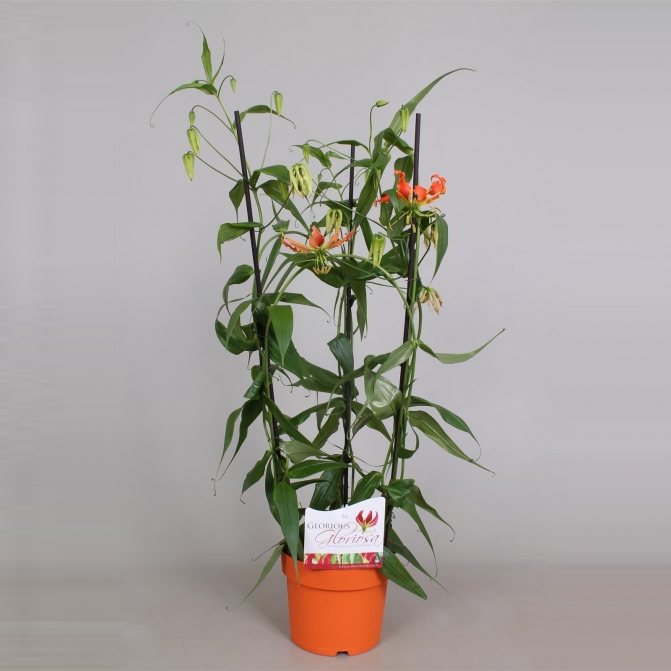
Gloriosa breeding methods
At home, Gloriosa can be propagated by seeds or by a vegetative method (tubers).
Seed propagation
Since the germination period of seeds is 9 months, you should not delay with their sowing. The optimal time for this is the end of February. The prepared containers are filled with a soil mixture consisting of leafy earth and peat. Seeds are carefully laid out, sprinkled with soil a little, slightly moistened, after which the container is covered with film or glass. The air temperature in the room should not be less than + 22 ° C. To prevent condensation from collecting, the soil does not dry out, the container should be regularly ventilated and, if necessary, watered. The first shoots will appear in 1-2 weeks.
Tuber propagation
It should be borne in mind that during the season, young branches grow on the Gloriosa tubers, which can be separated from each other. At the end of winter, they can be planted individually in small pots with a moist mixture of turf, leafy soil and sand.The nodule must necessarily have a growth bud. When planting, the tuber should be located bud up to a depth of 3 cm. The optimum air temperature for rooting seedlings is about + 22 ... + 24 ° C. With the emergence of a sprout, regular watering should be started as the soil surface dries out. It is advisable to immediately install a support for the plant.
Reproduction of gloriosa
Gloriosa reproduces vegetatively, by daughter plants, on an industrial scale and in very specific conditions - by dividing the tubers and by the seed method.
Adult glorioses usually form small new nodules next to the large maternal tuber, which can be detached and transplanted as independent plants. If you want to take a risk and get more plants from one tuber, then during transplanting in February or March, adult tubers can be cut into 2-3 pieces with a sharp knife, like a potato. In a plant, it is necessary to process all sections with crushed coal as carefully as possible. But whichever option you choose, divided tubers or small children must be planted in compact flower pots with a diameter of 12 to 15 cm, in a universal substrate with a loose texture.
In this case, it is necessary to place the tubers so that the growth point is directed upwards, and the substrate projection above the plant does not exceed 3 cm. For rooting, it is necessary to provide the bottom heating of the container at a temperature of about 22-24 degrees. In this case, the tubers must be kept in completely dry conditions until the moment when the first sprouts appear. As the shoots grow, they must be tied to a support. Plants are transplanted into larger containers only when the shoots become powerful and long.
When propagating from seeds, it is necessary to be prepared for the fact that gloriosa shoots develop very slowly and they will have to grow for 3 years before flowering. It is possible to independently obtain gloriosa seeds only with artificial pollination with a soft brush. Purchased gloriosa seeds will not bring success; they must be sown immediately after harvest. Gloriosa seeds are usually recommended to be sown in a mixture of peat, turf soil and sand in equal proportions, germinated under glass with mandatory frequent ventilation and a temperature of 22 to 24 degrees Celsius. Plants are grown until powerful enough shoots are formed, slowly transplanting them into separate pots.

